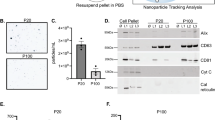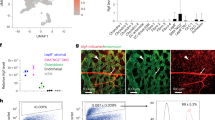Abstract
Reverse signaling via members of the tumor necrosis factor (TNF) superfamily controls multiple aspects of immune function. Here we document TNFα reverse signaling in the nervous system to our knowledge for the first time and show that it has a crucial role in establishing sympathetic innervation. During postnatal development, sympathetic axons express TNFα as they grow and branch in their target tissues, which in turn express TNF receptor 1 (TNFR1). In culture, soluble forms of TNFR1 act directly on postnatal sympathetic axons to promote growth and branching by a mechanism that depends on membrane-integrated TNFα and on downstream activation of ERK. Sympathetic innervation density is substantially lower in several tissues in postnatal and adult mice lacking either TNFα or TNFR1. These findings reveal that target-derived TNFR1 acts as a reverse-signaling ligand for membrane-integrated TNFα to promote growth and branching of sympathetic axons.
This is a preview of subscription content, access via your institution
Access options
Subscribe to this journal
Receive 12 print issues and online access
$209.00 per year
only $17.42 per issue
Buy this article
- Purchase on Springer Link
- Instant access to full article PDF
Prices may be subject to local taxes which are calculated during checkout






Similar content being viewed by others
References
Huber, A.B., Kolodkin, A.L., Ginty, D.D. & Cloutier, J.F. Signaling at the growth cone: ligand-receptor complexes and the control of axon growth and guidance. Annu. Rev. Neurosci. 26, 509–563 (2003).
Glebova, N.O. & Ginty, D.D. Growth and survival signals controlling sympathetic nervous system development. Annu. Rev. Neurosci. 28, 191–222 (2005).
Davies, A.M. Extracellular signals regulating sympathetic neuron survival and target innervation during development. Auton. Neurosci. 151, 39–45 (2009).
Glebova, N.O. & Ginty, D.D. Heterogeneous requirement of NGF for sympathetic target innervation in vivo. J. Neurosci. 24, 743–751 (2004).
Desbarats, J. et al. Fas engagement induces neurite growth through ERK activation and p35 upregulation. Nat. Cell Biol. 5, 118–125 (2003).
Zuliani, C. et al. Control of neuronal branching by the death receptor CD95 (Fas/Apo-1). Cell Death Differ. 13, 31–40 (2006).
O'Keeffe, G.W., Gutierrez, H., Pandolfi, P.P., Riccardi, C. & Davies, A.M. NGF-promoted axon growth and target innervation requires GITRL-GITR signaling. Nat. Neurosci. 11, 135–142 (2008).
Neumann, H. et al. Tumor necrosis factor inhibits neurite outgrowth and branching of hippocampal neurons by a rho-dependent mechanism. J. Neurosci. 22, 854–862 (2002).
Gutierrez, H., O'Keeffe, G.W., Gavalda, N., Gallagher, D. & Davies, A.M. Nuclear factor kappa B signaling either stimulates or inhibits neurite growth depending on the phosphorylation status of p65/RelA. J. Neurosci. 28, 8246–8256 (2008).
Gavalda, N., Gutierrez, H. & Davies, A.M. Developmental regulation of sensory neurite growth by the tumor necrosis factor superfamily member LIGHT. J. Neurosci. 29, 1599–1607 (2009).
Gutierrez, H. et al. Regulation of neurite growth by tumour necrosis superfamily member RANKL. Open Biol. 3, 120150 (2013).
Hehlgans, T. & Pfeffer, K. The intriguing biology of the tumour necrosis factor/tumour necrosis factor receptor superfamily: players, rules and the games. Immunology 115, 1–20 (2005).
Sun, M. & Fink, P.J. A new class of reverse signaling costimulators belongs to the TNF family. J. Immunol. 179, 4307–4312 (2007).
Eissner, G. et al. Reverse signaling through transmembrane TNF confers resistance to lipopolysaccharide in human monocytes and macrophages. J. Immunol. 164, 6193–6198 (2000).
Waetzig, G.H. et al. Soluble tumor necrosis factor (TNF) receptor-1 induces apoptosis via reverse TNF signaling and autocrine transforming growth factor-beta1. FASEB J. 19, 91–93 (2005).
Xin, L. et al. Dual regulation of soluble tumor necrosis factor-alpha induced activation of human monocytic cells via modulating transmembrane TNF-alpha-mediated 'reverse signaling'. Int. J. Mol. Med. 18, 885–892 (2006).
Yu, M. et al. Influence of reverse signaling via membrane TNF-alpha on cytotoxicity of NK92 cells. Eur. J. Cell Biol. 88, 181–191 (2009).
Black, R.A. et al. A metalloproteinase disintegrin that releases tumour-necrosis factor-alpha from cells. Nature 385, 729–733 (1997).
Deckwerth, T.L. et al. BAX is required for neuronal death after trophic factor deprivation and during development. Neuron 17, 401–411 (1996).
Vizard, T.N. et al. Regulation of axonal and dendritic growth by the extracellular calcium-sensing receptor. Nat. Neurosci. 11, 285–291 (2008).
Korner, H. et al. Distinct roles for lymphotoxin-alpha and tumor necrosis factor in organogenesis and spatial organization of lymphoid tissue. Eur. J. Immunol. 27, 2600–2609 (1997).
Pfeffer, K. et al. Mice deficient for the 55 kd tumor necrosis factor receptor are resistant to endotoxic shock, yet succumb to L. monocytogenes infection. Cell 73, 457–467 (1993).
Kirchner, S. et al. LPS resistance in monocytic cells caused by reverse signaling through transmembrane TNF (mTNF) is mediated by the MAPK/ERK pathway. J. Leucoc. Biol. 75, 324–331 (2004).
Gomez, N. & Cohen, P. Dissection of the protein kinase cascade by which nerve growth factor activates MAP kinases. Nature 353, 170–173 (1991).
Thompson, J., Dolcet, X., Hilton, M., Tolcos, M. & Davies, A.M. HGF promotes survival and growth of maturing sympathetic neurons by PI-3 kinase- and MAP kinase-dependent mechanisms. Mol. Cell Neurosci. 27, 441–452 (2004).
Goold, R.G. & Gordon-Weeks, P.R. The MAP kinase pathway is upstream of the activation of GSK3beta that enables it to phosphorylate MAP1B and contributes to the stimulation of axon growth. Mol. Cell Neurosci. 28, 524–534 (2005).
Favata, M.F. et al. Identification of a novel inhibitor of mitogen-activated protein kinase. J. Biol. Chem. 273, 18623–18632 (1998).
Watts, A.D. et al. A casein kinase I motif present in the cytoplasmic domain of members of the tumour necrosis factor ligand family is implicated in 'reverse signalling'. EMBO J. 18, 2119–2126 (1999).
Wiegert, J.S. & Bading, H. Activity-dependent calcium signaling and ERK-MAP kinases in neurons: a link to structural plasticity of the nucleus and gene transcription regulation. Cell Calcium 49, 296–305 (2011).
Park, K.M. & Bowers, W.J. Tumor necrosis factor-alpha mediated signaling in neuronal homeostasis and dysfunction. Cell Signal. 22, 977–983 (2010).
Reich, A., Spering, C. & Schulz, J.B. Death receptor Fas (CD95) signaling in the central nervous system: tuning neuroplasticity? Trends Neurosci. 31, 478–486 (2008).
Xanthoulea, S. et al. Tumor necrosis factor (TNF) receptor shedding controls thresholds of innate immune activation that balance opposing TNF functions in infectious and inflammatory diseases. J. Exp. Med. 200, 367–376 (2004).
Islam, A. et al. Extracellular TNFR1 release requires the calcium-dependent formation of a nucleobindin 2-ARTS-1 complex. J. Biol. Chem. 281, 6860–6873 (2006).
Harashima, S. et al. Outside-to-inside signal through the membrane TNF-alpha induces E-selectin (CD62E) expression on activated human CD4+ T cells. J. Immunol. 166, 130–136 (2001).
Barker, V., Middleton, G., Davey, F. & Davies, A.M. TNFalpha contributes to the death of NGF-dependent neurons during development. Nat. Neurosci. 4, 1194–1198 (2001).
Takei, Y. & Laskey, R. Tumor necrosis factor alpha regulates responses to nerve growth factor, promoting neural cell survival but suppressing differentiation of neuroblastoma cells. Mol. Biol. Cell 19, 855–864 (2008).
Davies, A.M., Lee, K.F. & Jaenisch, R. p75-deficient trigeminal sensory neurons have an altered response to NGF but not to other neurotrophins. Neuron 11, 565–574 (1993).
Gutierrez, H. & Davies, A.M. A fast and accurate procedure for deriving the Sholl profile in quantitative studies of neuronal morphology. J. Neurosci. Methods 163, 24–30 (2007).
Ronn, L.C. et al. A simple procedure for quantification of neurite outgrowth based on stereological principles. J. Neurosci. Methods 100, 25–32 (2000).
Gallagher, D. et al. Nuclear factor-kappaB activation via tyrosine phosphorylation of inhibitor kappaB-alpha is crucial for ciliary neurotrophic factor-promoted neurite growth from developing neurons. J. Neurosci. 27, 9664–9669 (2007).
Acknowledgements
We thank M. White for providing RNA samples and K. Fox (Cardiff University), A. Dick (Bristol University) and the late S. Korsmeyer for providing Tnf, Tnfrsf1a and Bax mutant mice, respectively. This work was supported by a Wellcome Trust grant (grant no. 085984). C.O. was supported by a grant from the Fundação para a Ciência e a Tecnologia. C.E. was supported by a studentship from the Neuroscience and Mental Health Research Institute of Cardiff University.
Author information
Authors and Affiliations
Contributions
L.K. conducted the majority of the cell culture experiments, quantified submandibular gland and iris innervation and did the western blot analysis. C.O. quantified nasal tissue and adult submandibular gland innervation. C.E. undertook the immunocytochemical and immunohistochemical localization of TNFα and TNFR1 and the whole-mount studies. T.V. contributed to studies of iris innervation. S.W. carried out the QPCR. L.K. and A.M.D. wrote the manuscript. A.M.D. supervised the project.
Corresponding author
Ethics declarations
Competing interests
The authors declare no competing financial interests.
Supplementary information
Supplementary Text and Figures
Supplementary Figures 1–3 (PDF 3772 kb)
Rights and permissions
About this article
Cite this article
Kisiswa, L., Osório, C., Erice, C. et al. TNFα reverse signaling promotes sympathetic axon growth and target innervation. Nat Neurosci 16, 865–873 (2013). https://doi.org/10.1038/nn.3430
Received:
Accepted:
Published:
Issue Date:
DOI: https://doi.org/10.1038/nn.3430
This article is cited by
-
Thermogenic adipocyte-derived zinc promotes sympathetic innervation in male mice
Nature Metabolism (2023)
-
The sympathetic nervous system in development and disease
Nature Reviews Neuroscience (2021)
-
How CD40L reverse signaling regulates axon and dendrite growth
Cellular and Molecular Life Sciences (2021)
-
Coupling of bone resorption and formation by RANKL reverse signalling
Nature (2018)
-
Dynamic control of proinflammatory cytokines Il-1β and Tnf-α by macrophages in zebrafish spinal cord regeneration
Nature Communications (2018)



